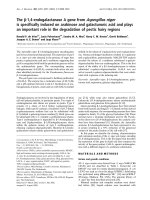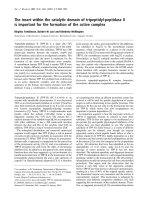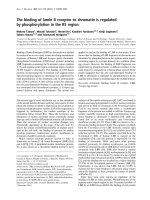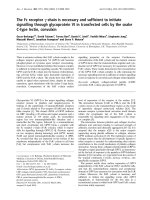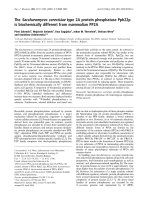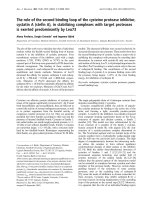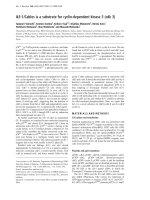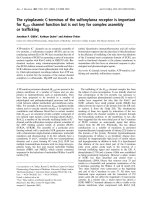Báo cáo y học: "The P2X7 receptor is a candidate product of murine and human lupus susceptibility loci: a hypothesis and comparison of murine allelic products" potx
Bạn đang xem bản rút gọn của tài liệu. Xem và tải ngay bản đầy đủ của tài liệu tại đây (538.85 KB, 8 trang )
Open Access
Available online />R468
Vol 7 No 3
Research article
The P2X
7
receptor is a candidate product of murine and human
lupus susceptibility loci: a hypothesis and comparison of murine
allelic products
James I Elliott, John H McVey and Christopher F Higgins
MRC Clinical Sciences Centre, Faculty of Medicine, Imperial College, Hammersmith Hospital Campus, London, UK
Corresponding author: James I Elliott,
Received: 20 Oct 2004 Revisions requested: 30 Nov 2004 Revisions received: 18 Jan 2005 Accepted: 21 Jan 2005 Published: 21 Feb 2005
Arthritis Research & Therapy 2005, 7:R468-R475 (DOI 10.1186/ar1699)
/>© 2005 Elliott et al., licensee BioMed Central Ltd.
This is an Open Access article distributed under the terms of the Creative Commons Attribution License ( />2.0), which permits unrestricted use, distribution, and reproduction in any medium, provided the original work is properly cited.
Abstract
Systemic lupus erythematosus and its murine equivalent,
modelled in the New Zealand Black and New Zealand White
(NZB × NZW)F
1
hybrid strain, are polygenic inflammatory
diseases, probably reflecting an autoimmune response to debris
from cells undergoing programmed cell death. Several human
and murine loci contributing to disease have been defined. The
present study asks whether the proinflammatory purinergic
receptor P2X
7
, an initiator of a form of programmed cell death
known as aponecrosis, is a candidate product of murine and
human lupus susceptibility loci. One such locus in (NZB ×
NZW)F
1
mice is lbw3, which is situated at the distal end of NZW
chromosome 5. We first assess whether NZB mice and NZW
mice carry distinct alleles of the P2RX
7
gene as expressed by
common laboratory strains, which differ in sensitivity to ATP
stimulation. We then compare the responses of NZB
lymphocytes, NZW lymphocytes and (NZB × NZW)F
1
lymphocytes to P2X
7
stimulation. NZB and NZW parental
strains express the distinct P2X
7
-L and P2X
7
-P alleles of P2RX
7
,
respectively, while lymphocytes from these and (NZB × NZW)F
1
mice differ markedly in their responses to P2X
7
receptor
stimulation. NZB mice and NZW mice express functionally
distinct alleles of the proinflammatory receptor, P2X
7
. We show
that current mapping suggests that murine and human P2RX
7
receptor genes lie within lupus susceptibility loci lbw3 and
SLEB4, and we argue that these encode a product with the
functional characteristics consistent with a role in lupus.
Furthermore, we argue that aponecrosis as induced by P2X
7
is
a cell death mechanism with characteristics that potentially have
particular relevance to disease pathogenesis.
Introduction
Systemic lupus erythematosus (SLE) is a polygenic dis-
ease, although the genes contributing towards the disease
are unknown. Several human susceptibility loci have been
identified, with eight of the strongest candidates mapping
to 1q23, 1q25-31, 1q41-42, 2q35-37, 4p16-15.2, 6p11-
21, 12q24 and 16q12 [1]. Of the murine models, the New
Zealand Black and New Zealand White (NZB × NZW)F
1
hybrid strain is widely studied due to its similarity to human
disease and its female preponderance. As with human SLE,
the disorder of (NZB × NZW)F
1
mice is polygenic with a
contribution from both parents. In a study of (NZB ×
NZW)F
2
mice, eight susceptibility loci were identified [2]. In
the case of the locus lbw3, at the distal region of chromo-
some 5, homozygosity for the NZW-derived locus was
associated with increased mortality at 12 months. Although
originally mapped to 88 cM on murine chromosome 5 [2],
more recent data locate the microsatellite used to define
lbw3 at 81 cM (discussed later).
We have studied the properties of the proinflammatory
purinergic receptor P2X
7
, encoded by a gene within the
human SLE locus SLEB4 [3] at 12q24 (Ensembl Genome
Browser: />tigview?chr=12&vc_start=119982631&vc_end=12009&
highlight=ENSG00000089041) and by the murine lbw3
region (Ensembl Genome Browser:
http:www.ensembl.org/Mus_musculus/con
BzATP = 2'-3'-O-(4-benzoylbenzoyl)-adenosine 5'-triphosphate; DMEM = Dulbecco's modified Eagle's medium; ELISA = enzyme-linked immunosorb-
ent assay; FCS = foetal calf serum; FITC = fluorescein isothiocyanate; IL = interleukin; NZB = New Zealand Black; NZW = New Zealand White; PCD
= programmed cell death; PCR = polymerase chain reaction; PS = phosphatidylserine; SLE = systemic lupus erythematosus.
Arthritis Research & Therapy Vol 7 No 3 Elliott et al.
R469
tigview?&chr=5&vc_start=119870152&vc_end=11987),
and discuss its potential role in disease. The P2X
7
receptor
belongs to a family of ion channels gated by extracellular
ATP, but unlike other P2X receptors it is largely restricted
to haematopoietic cells. The P2X
7
receptor has been pro-
posed to play a role in a variety of immune functions includ-
ing the secretion of leaderless cytokines and the shedding
of the lymphocyte homing receptor CD62L [4]. As P2X
7
-
deficient mice exhibit resistance to antibody-induced arthri-
tis and impaired CD62L shedding and IL-1β secretion [5],
stimulation of this receptor is proinflammatory – suggesting
a potential role in autoimmune disease.
In this respect, SLE is of particular interest. Not only is SLE
an inflammatory disorder, but it probably reflects, at least in
part, an immune response to debris of cells undergoing
programmed cell death (PCD). As P2X
7
stimulation is
proinflammatory and induces PCD, functional polymor-
phisms in this gene would be predicted to affect lupus sus-
ceptibility. Moreover, PCD stimulated through the P2X
7
receptor belongs to a category that bears many of the hall-
marks of 'classic' caspase-dependent apoptosis, but also
to other categories such as cytoplasmic vacuolization more
often associated with necrosis. Such cell death has some-
times been termed 'aponecrosis' [6]. Whereas removal of
'classic' apoptotic cells is believed to be immunologically
silent, necrotic cell debris is proinflammatory [7]. The effect
of intermediate forms of PCD such as aponecrosis, for
which clearance mechanisms have not been defined, is
unknown, yet such material potentially plays a significant
role in the pathogenesis of SLE (discussed later). Finally,
P2X
7
stimulation results in rapid translocation of phosphati-
dylserine (PS) from the inner to the outer leaflet of the
plasma membrane, which is reversible if stimulation is brief
(and thus independent of cell death). As PS and associated
proteins are major targets of autoantibodies in SLE [8],
cells stimulated via the P2X
7
receptor may be a significant
source of autoantigen in this disease.
An allelic variation (P451L) of the cytoplasmic domain of
the P2X
7
receptor in commonly used mouse strains is asso-
ciated with significant differences in its sensitivity to the
ATP ligand [9]. These allelic forms with proline (P2X
7
-P)
and leucine (P2X
7
-L) at position 451 confer high sensitivity
and low sensitivity to stimulation by ATP, respectively.
While the NZW strain has been shown to express the more
responsive allele of P2X
7
(P2X-P) [9], that expressed by the
NZB strain is unknown. We show in the present article that
NZB mice and NZW mice express different alleles of the
proinflammatory receptor P2X
7
, and furthermore that NZW
lymphocytes are markedly more responsive to P2X
7
stimu-
lation than those from NZB mice. Lymphocytes from (NZB
× NZW)F
1
mice exhibited intermediate sensitivities to
P2X
7
-induced PS translocation and to PCD, but were as
sensitive to induction of CD62L shedding as those from
NZW mice, indicating a comparatively complex phenotypic
penetration. The results indicate that P2X
7
is a strong can-
didate for being the product of the murine lbw3 locus. As
the human P2RX
7
gene maps close to SLEB4, we hypoth-
esize that similar polymorphisms may also contribute
towards human disease.
Methods
Mice
Male mice were purchased from Harlan-Olac (Bicester,
UK) and used at between 8 and 14 weeks. Institute guide-
lines for care of laboratory animals were followed. All stud-
ies received ethical review approval.
P2X
7
PCRs
PCR amplification of the NZB mouse genomic sequence
encompassing the T1352C polymorphism [9] was per-
formed using the forward and reverse primers CCT-
GTCTAGGCTGTCCCTAT and
GCTTATGGAAGAGCTTGGAG for 30 cycles. PCR prod-
ucts were cloned using the TOPO TA cloning system (Inv-
itrogen, Paisley, UK). Forty-three independent clones were
sequenced using an ABI PRISM Big Dye terminator ready
reaction kit (Applied Biosystems, Warrington, UK) and
were analysed on a 3700 DNA Analyser (Applied Biosys-
tems). Nucleotide and amino acid substitutions were num-
bered using the cDNA sequence accession number NM-
011027.
Reagents
Matrix metalloproteinase inhibitor III was from Calbiochem
(Nottingham, UK). Other reagents were from Sigma (Poole,
UK), unless stated. Diluents had no effect in any assay
used.
Flow cytometry
Mesenteric lymphocyte cells (10
7
/ml) in phenol red-free
DMEM were stained with a combination of CD4
APC
,
CD4
CYCHROME
, CD4
PE
, CD8
APC
, CD8
CYCHROME
, CD8
PE
,
CD8
FITC
and CD62L
FITC
antibodies (Becton Dickinson,
Oxford, UK) as indicated, washed and resuspended in
DMEM. Cells were equilibrated with annexin V
FITC
or
annexin V
CY5
(Becton Dickinson) to assess cell surface PS
exposure, or with propidium iodide for 4 min to assess cell
death, and were analysed by flow cytometry on a FACScal-
ibur machine using CellQuest (Becton Dickinson) or Flowjo
(Tree Star, Ashland, OR, USA) software. Baseline fluores-
cence was established for approximately 1 min prior to
addition of 150 µM (unless otherwise stated) 2'-3'-O-(4-
benzoylbenzoyl)-adenosine 5'-triphosphate (BzATP). Cells
were monitored for PS exposure or CD62L shedding con-
tinuously in real time for up to 9 min or were monitored for
uptake of propidium iodide, as indicated. All results are rep-
resentative of at least three independent experiments.
Available online />R470
IL-1β secretion
Spleens from NZW mice and NZB mice were disaggre-
gated and erythrocytes were lysed (Puregene RBC lysis
solution; Gentra Ltd, Minneapolis, MN, USA). Splenocytes
(5 × 10
6
/ml) were then resuspended in DMEM supple-
mented with 10% FCS (Helena Biosciences, Sunderland,
UK), and were stimulated with 2 µg/ml lipopolysaccharide.
After 6 hours at 37°C the medium was removed and
replaced with DMEM. Cells were then incubated at 37°C
for 30 min with BzATP added as indicated. The superna-
tant was then collected and the cells and particulate matter
were removed by centrifugation. Supernatants were then
frozen at -20°C. IL-1β was quantified by ELISA (Quantikine
mouse IL-1β kit; R&D Systems, Minneapolis, MN, USA) in
accordance with the manufacturer's instructions. Statistical
significance was measured by Student's t test.
Results
Real-time comparison of P2X
7
-stimulated PS
translocation and CD62L shedding by NZW, (NZB ×
NZW)F
1
and NZB lymphocytes
We initially confirmed that NZW mice are homozygous for
the P2X-P allele of P2RX
7
[9] associated with high sensitiv-
ity to stimulation, and we showed that NZB mice are
homozygous for the low sensitivity allele P2X-L (data not
shown). These forms differ at a single amino acid (451).
P2X
7
activation, stimulated by BzATP (Fig. 1), results in
rapid externalization of PS and shedding of CD62L. We
therefore developed real-time flow cytometric assays to
directly compare the responses to P2X
7
simulation of NZB
lymphocytes, NZW lymphocytes and (NZB × NZW)F
1
lym-
phocytes.
PS translocation
PS is largely confined to the inner leaflet of the plasma
membrane in healthy cells. Loss of lipid asymmetry, as evi-
denced by surface exposure of PS occurring prior to mem-
brane breakdown, is generally assumed to be a marker of
PCD. To enable the direct comparison of responses of
cells from NZB mice, NZW mice and (NZB × NZW)F
1
mice
in a single tube, lymphocytes from these three strains were
stained with anti-CD4
CYCHROME
, anti-CD4
PE
and anti-
CD4
APC
, respectively, mixed and equilibrated with annexin
V
FITC
(to detect exposed PS). Labelled cells could thus sub-
sequently be distinguished by flow cytometric gating. The
rates of P2X
7
-stimulated PS exposure by lymphocyte sub-
sets derived from the three mouse strains were directly
compared by real-time flow cytometry (Fig. 1). Baseline flu-
orescence was established, and cells were stimulated with
the P2X
7
agonist BzATP at the time indicated. The order of
responsiveness to P2X
7
stimulation, as evidenced by the
percentage of cells translocating PS, was consistently
NZW > (NZB × NZW)F
1
> NZB. Therefore, consistent with
the greater sensitivity of P2X
7
-P, lymphocytes from NZW
mice show greater sensitivity to P2X
7
stimulation, and show
co-dominance with the NZB-derived allele (P2X
7
-L) in F
1
hybrid mice.
CD62L shedding
Shedding of CD62L from T cells is a key event in lym-
phocyte migration to inflammatory sites [10] and is known
to be induced by P2X
7
stimulation. Lymphocytes from NZB
mice, NZW mice and (NZB × NZW)F
1
mice were differen-
tially stained as already stated but were labelled with FITC-
conjugated anti-CD62L in place of annexin V
FITC
to allow
direct comparison of the rate of CD62L shedding in a sin-
gle tube. P2X
7
-stimulated CD62L shedding was apparent
as a decrease in fluorescence in the FL-1 channel. While
the rates of P2X
7
-stimulated CD62L shedding were high
and low in NZW lymphocytes and NZB lymphocytes,
respectively (Fig. 2), interestingly the rate of CD62L shed-
ding by (NZB × NZW)F
1
lymphocytes was indistinguisha-
Figure 1
P2X
7
-stimulated phosphatidylserine (PS) exposure on lymphocytesP2X
7
-stimulated phosphatidylserine (PS) exposure on lymphocytes.
P2X
7
-dependent exposure of PS on New Zealand Black (NZB) lym-
phocytes, New Zealand White (NZW) lymphocytes and (NZB ×
NZW)F
1
(NZB/W) lymphocytes. To enable the direct comparison of
responses of cells from NZB mice, NZW mice and (NZB × NZW)F
1
mice in a single tube, lymphocytes from these strains were stained with
anti-CD4
CYCHROME
, anti-CD4
PE
and anti-CD4
APC
, respectively, mixed
and equilibrated with annexin V
FITC
. Thus labelled, cells could subse-
quently be distinguished by flow cytometric gating. Cells were stimu-
lated with the P2X
7
agonist 2'-3'-O-(4-benzoylbenzoyl)-adenosine 5'-
triphosphate (BzATP) at the time indicated by the arrow in (a). (a) Den-
sity plots of the rate of extracellular PS exposure in each cell population,
as indicated by increased binding of annexin V
FITC
. (b) Corresponding
percentage of cells bearing exposed PS in each population at a single
timepoint (indicated by boxes in (a)).
Arthritis Research & Therapy Vol 7 No 3 Elliott et al.
R471
ble from that by NZW cells. The high NZW response of
P2X
7
thus appears dominant with respect to CD62L shed-
ding, indicating that factors downstream of P2X
7
stimula-
tion contribute to this phenotype. That loss of CD62L
reflects shedding and not decreased cell surface expres-
sion through other mechanisms is evidenced by its block-
ade by an inhibitor of matrix metalloproteinase [11] (Fig.
2c).
Figure 2
P2X
7
-stimulated shedding of CD62L by lymphocytesP2X
7
-stimulated shedding of CD62L by lymphocytes. To enable the direct comparison of responses of cells from New Zealand Black (NZB) mice,
New Zealand White (NZW) mice and (NZB × NZW)F
1
(NZB/W) mice in a single tube, lymphocytes from these strains were stained with anti-
CD4
PE
, anti-CD4
CYCHROME
and anti-CD4
APC
, respectively, mixed and stained with anti-CD62L
FITC
. Thus labelled, cells could subsequently be distin-
guished by flow cytometric gating. Cells were stimulated with the P2X
7
agonist 2'-3'-O-(4-benzoylbenzoyl)-adenosine 5'-triphosphate (BzATP) at the
time indicated by the arrow in (a). (a) Density plots of the rate of CD62L shedding in each cell population, as indicated by decreased binding of anti-
CD62L
FITC
. (b) Corresponding levels of cell surface CD62L in each population (NZB, red line; NZW, green line; NZB/W, black line) immediately
preceding P2X
7
stimulation (indicated by left-hand gates in (a)) or 7 min after P2X
7
stimulation (indicated by right-hand gates in (a)). (c) Effect of a
broad inhibitor of metalloproteinases on loss of CD62L. Lymphocytes from NZW mice were stained with anti-CD4
CYCHROME
and anti-CD62L
PE
, and
the rate of loss of CD62L was assessed by flow cytometry. Cells were stimulated with BzATP in the presence or absence of 10 µM metalloprotein-
ase inhibitor at the time indicated by an arrow. Shedding of CD62L is indicated by decreased binding of anti-CD62L
PE
. MMP, matrix
metallopoteinase.
Available online />R472
P2X
7
-induced secretion of IL-1β
Stimulation of the P2X
7
receptor on lipopolysaccharide-
stimulated monocytes and macrophages promotes secre-
tion of the proinflammatory cytokine IL-1β [5,12], which
may therefore be expected to differ between mice bearing
P2X
7
-L or P2X
7
-P receptors. Indeed IL-1β secretion by
NZW splenocytes stimulated in vitro with lipopolysaccha-
ride and BzATP exceeded that by cells from NZB mice (P
< 0.05 at 50, 100 and 150 µM BzATP; Fig. 3). Elevated IL-
1β secretion by NZW splenocytes was apparent even in
the absence of BzATP (although slightly below statistical
significance), suggesting that inadvertent stimulation of the
high (but not low) sensitivity P2X
7
receptor may have
occurred through cell death and the consequent release of
ATP during cell preparation (spleen disaggregation and
erythrocyte lysis). In one NZW splenocyte preparation
exhibiting particularly high IL-1β secretion, cells were
refractory to further stimulation of the P2X
7
receptor in
vitro.
P2X
7
-induced PCD of NZW and NZB lymphocytes
Several lines of evidence indicate that lupus reflects an
autoimmune response to debris from cells undergoing
PCD. Although stimulation of P2X
7
results in rapid PS
translocation, the effects are reversible if exposure to the
agonist is brief [4]. Only prolonged treatment with agonist
results in PCD. Translocation of PS following P2X
7
activa-
tion cannot therefore be used as a direct measure of irre-
versible commitment to PCD. To measure PCD following
prolonged P2X
7
stimulation, we therefore compared the
rate of terminal membrane breakdown (indicated by propid-
ium iodide uptake) following BzATP treatment of NZW lym-
phocytes, NZB lymphocytes and (NZB × NZW)F
1
lymphocytes (Fig. 4). P2X
7
stimulation resulted in signifi-
cant PCD in all populations tested, with the order of sensi-
tivity NZW > (NZB × NZW)F
1
> NZB, consistent with the
high responder status of the NZW cells and the dominance
of the NZW-derived P2RX
7
allele in this response.
Figure 3
P2X
7
-stimulated secretion of IL-1βP2X
7
-stimulated secretion of IL-1β. Splenocytes were primed in vitro
with lipopolysaccharide and were then stimulated with 2'-3'-O-(4-ben-
zoylbenzoyl)-adenosine 5'-triphosphate (BzATP) as indicated. The
graph shows IL-1β secretion by cells from New Zealand Black mice
(open squares) and New Zealand White mice (filled squares). Each line
represents IL-1β secretion by cells from a single mouse.
Figure 4
P2X
7
-stimulated lymphocyte programmed cell death (PCD)P2X
7
-stimulated lymphocyte programmed cell death (PCD). Lym-
phocytes from New Zealand Black (NZB) mice, New Zealand White
(NZW) mice and (NZB × NZW)F
1
(NZB/W) mice were stained with
anti-CD4
APC
and anti-CD8
FITC
, and were equilibrated with propidium
iodide (PI). Panels show the mean percentage (± standard deviation, n
= 5) of dead cells (those taking up PI) as assessed by flow cytometry
before (t = 0), and at 15-min intervals subsequent to, stimulation of the
P2X
7
receptor with 2'-3'-O-(4-benzoylbenzoyl)-adenosine 5'-triphos-
phate. (a) CD4
+
cells, and (b) CD8
+
cells. NZB, open squares; NZW,
open circles; NZB/W, open diamonds.
Arthritis Research & Therapy Vol 7 No 3 Elliott et al.
R473
Discussion
Stimulation of the proinflammatory haematopoietic P2X
7
receptor [5] results in IL-1β secretion, in high rates of PCD
[4] and in CD62L shedding [13], each of which is associ-
ated with human SLE [14-16]. The P2X
7
receptor therefore
has the characteristics of a candidate lupus susceptibility
gene product. Moreover, the gene encoding human P2X
7
is located within a region (12q24; Ensembl Genome
Browser: />tigview?chr=12&vc_start=119982631&vc_end=12009&
highlight=ENSG00000089041) recently identified and
confirmed in Hispanic and European-American Families as
a lupus susceptibility locus, designated SLEB4 [3].
A polymorphism in the cytoplasmic domain of the P2X
7
receptor of common mouse strains is associated with
differential responsiveness [9]. While most strains, includ-
ing NZW mice [9], possess proline in amino acid position
451, we showed that NZB mice express P2X
7
with lysine
at this position and that the variant confers markedly
decreased sensitivity to P2X
7
stimulation. Notably, the
murine P2RX
7
gene is encoded by a gene on chromosome
5 within a region designated lbw3 due to the identification
of a NZW-derived susceptibility locus conferring increased
mortality at 12 months [2]. While susceptibility regions are
broad, the microsatellite marker D5Mit101 (defining lbw3
[2]) was in the original study mapped to 88 cM on chromo-
some 5, which may have discouraged identification of
P2RX
7
as a candidate susceptibility gene. Current mapping
data, however, show this marker located at 81 cM – Mouse
Genome Informatics />javawi2/servlet/WIFetch?page=markerDetail&key=6077a
and Ensembl Genome Browser />Mus_musculus/markerview?marker=D5Mit101. As the
marker D5Mit118 that is adjacent to P2RX
7
is located at 67
cM – Ensembl Genome Browser
http:www.ensembl.orMus_musculus/con
tigview?&chr=5&vc_start=119870152&vc_end=11987
and Mouse Genome Informatics ormat
ics.jax.org/javawi2/servlet/WIFetch?page=mark
eril&key=6095 – the two are approximately 14 cM (or 19
Mb) apart (120 Mb versus 139 Mb), easily within the 20 cM
distance used by Kono and colleagues [2] to define cover-
age by markers in their study.
Although gene polymorphisms may have unpredicted
effects, other than P2RX
7
there appear to be few candidate
susceptibility genes (based on lymphoid expression and
protein activity) in the region described by lbw3. However,
other candidates might include those encoding: lnk, an
adaptor protein in T-cell signalling (65.0 cM) [17]; P2X
4
, a
purinergic receptor (65.0 cM) whose activity is assumed
primarily to be neuronal, but which is also expressed (at
least at the level of mRNA) in lymphocytes [18]; shp2, a
tyrosine phosphatase [19] (~66 cM [118.6 Mb]); and FLT3
(CD135, 82.0 cM), a tyrosine kinase expressed in haema-
otopoietic cells [20]. None of these has been reported to
be polymorphic between NZB mice and NZW mice.
It is widely thought that lupus reflects an autoimmune
response to cells undergoing PCD. Aberrant responses to
such debris may reflect qualitative or quantitative abnormal-
ities; for example, if its handling is defective and/or follow-
ing exposure to increased levels of 'apoptotic' material.
Both have been reported to contribute to human SLE
[15,16]. That prolonged stimulation of the P2X
7
receptor
induces PCD is therefore of particular note. However, mul-
tiple pathways of PCD exist. While 'apoptosis' and 'PCD'
are frequently used as synonyms, 'apoptosis' is often used
to imply caspase-dependent cell death. Nevertheless, cas-
pase involvement is not a good indicator of the physiologic
importance, or 'programming', of a cell death pathway, and
consequently classic 'apoptosis' may describe one end of
a continuum of active PCD mechanisms [21]. Hence, in
principle, a defect in one of many PCD pathways, rather
than increased susceptibility to PCD per se, may be suffi-
cient to increased the burden of cellular debris and hence
the susceptibility to lupus. Indeed, that SLE may reflect an
autoimmune response to debris from 'apoptotic' cells,
despite clearance of such material being thought generally
immunologically silent [7], has been a conundrum.
To reconcile these findings it has been suggested that, in
SLE, mechanisms for removing apoptotic debris are over-
loaded, with remaining cells undergoing secondary necro-
sis, and/or that apoptotic cells have some
immunostimulatory properties [7]. We suggest the
additional possibility that different forms of PCD may give
rise to debris with different degrees of immunogenicity. It is
therefore necessary to dissect distinct PCD pathways to
assess the potential effects that defects have on the dis-
ease process. It is attractive to speculate that P2X
7
-
induced aponecrotic debris, perhaps due to the cata-
strophic nature of its generation or the apparent differences
in cell dismantling, may be more necrotic than apoptotic in
character and thus be immunostimulatory. Such material
may either promote responses to surrounding 'apoptotic'
cells and/or directly stimulate autoimmune responses to
itself (if lupus autoantigens are appropriately packaged in
P2X
7
-induced PCD). P2X
7
receptor-induced PCD is there-
fore potentially a source of lupus autoantigens or may rep-
resent a catastrophic form of cell death that overwhelms
the host's ability to clear such material.
We therefore suggest the following involvement of the
P2X
7
receptor in SLE. ATP exists at very high concentra-
tions in normal cells (5–10 mM), and is released upon cell
death before its rapid breakdown by ATPases. Conse-
quently, extracellular concentrations of ATP, although
normally low, are transiently increased at sites of tissue
Available online />R474
damage. Stimulation of P2X
7
occurs at sufficient concen-
trations of ATP, resulting in secretion of IL-1β and in
CD62L shedding within minutes. P2X
7
stimulation thus
acts to promote the inflammatory response. The resulting
lymphoid infiltration leads to additional lymphocyte-medi-
ated cell death, and to consequent ATP release, exacerbat-
ing the P2X
7
-driven inflammatory cycle. Indeed, given
sufficient tissue damage, prolonged stimulation of P2X
7
itself induces PCD, further adding to the cycle of ATP
release and destruction. Release of autoantigens within
P2X
7
-stimulated aponecrotic debris may also contribute to
a breakdown in self-tolerance and initiation of
autoimmunity.
While one must make the proviso that little is known at the
moment about the level of ATP released at sites of tissue
damage, its rate of decay and how these may vary between
pathological conditions including SLE, we suggest it is rea-
sonable to hypothesize that polymorphisms within P2X
7
can influence the pathogenesis of lupus. Importantly, there
are a number of polymorphisms within P2X
7
that affect its
activity. The Ile-568 to Asn [22], Arg307 to Gln [23], and
Glu496 to Ala [24] polymorphisms therefore all result in
reduced function of human P2X
7
, and might each be
hypothesized to result in decreased severity of SLE.
Conclusions
In summary, we have shown that polymorphism of the P2X
7
receptor between NZW and NZB strains is associated with
marked differences in P2X
7
-stimulated proinflammatory
responses, consistent with high responsiveness and low
responsiveness previously reported for the two alleles. We
also show that current genetic mapping indicates that the
P2RX
7
gene is located within the region defined as lbw3
and is a therefore a strong candidate for being the product
of this lupus susceptibility locus. Furthermore, as the
human gene maps very close to SLEB4, we hypothesize
that polymorphisms within P2RX
7
may also contribute to
human disease. Stimulation of the P2X
7
receptor is proin-
flammatory and induces a form of cell death known as
aponecrosis, which exhibits several characteristics of
apoptosis. We therefore suggest that the P2X
7
receptor
and gene have the functional and positional characteristics
suggestive of a role in the pathogenesis in SLE, and that
the potential of the cell death mechanism aponecrosis to
contribute to disease warrants study.
Competing interests
The author(s) declare there are no competing interests.
Authors' contributions
JIE conceived the study, carried out the flow cytometric and
IL-1β secretion experiments, and wrote the first draft of the
manuscript. JHM designed allele-specific primers and
typed the P2RX
7
genes of NZB mice and NZW mice, and
contributed to drafting of the manuscript. CFH contributed
to the design of experiments and drafting of the manuscript.
All authors read and approved the final manuscript.
Acknowledgements
This work was supported by the Medical Research Council of Great
Britain. The authors would like to thank Dr T Vyse for helpful discussions.
References
1. Tsao BP: Update on human systemic lupus erythematosus
genetics. Curr Opin Rheumatol 2004, 16:513-521.
2. Kono DH, Burlingame RW, Owens DG, Kuramochi A, Balderas
RS, Balomenos D, Theofilopoulos AN: Lupus susceptibility loci
in New Zealand mice. Proc Natl Acad Sci 1994,
91:10168-10172.
3. Nath SK, Quintero-Del-Rio AI, Kilpatrick J, Feo L, Ballesteros M,
Harley JB: Linkage at 12q24 with systemic lupus erythemato-
sus (SLE) is established and confirmed in Hispanic and Euro-
pean American families. Am J Hum Genet 2004, 74:73-82.
4. MacKenzie A, Wilson HL, Kiss-Toth E, Dower SK, North RA, Sur-
prenant A: Rapid secretion of interleukin-1beta by microvesicle
shedding. Immunity 2001, 15:825-835.
5. Labasi JM, Petrushova N, Donovan C, McCurdy S, Lira P, Payette
MM, Brissette W, Wicks JR, Audoly L, Gabel CA: Absence of the
P2X7 receptor alters leukocyte function and attenuates an
inflammatory response. J Immunol 2002, 168:6436-6445.
6. Formigli L, Papucci L, Tani A, Schiavone N, Tempestini A, Orlandini
GE, Capaccioli S, Orlandini SZ: Aponecrosis: morphological
and biochemical exploration of a syncretic process of cell
death sharing apoptosis and necrosis. J Cell Physiol 2000,
182:41-49.
7. Savill J, Dransfield I, Gregory C, Haslett C: A blast from the past:
clearance of apoptotic cells regulates immune responses. Nat
Rev Immunol 2002, 2:965-975.
8. McClain MT, Arbuckle MR, Heinlen LD, Dennis GJ, Roebuck J,
Rubertone MV, Harley JB, James JA: The prevalence, onset, and
clinical significance of antiphospholipid antibodies prior to
diagnosis of systemic lupus erythematosus. Arthritis Rheum
2004, 50:1226-1232.
9. Adriouch S, Dox C, Welge V, Seman M, Koch-Nolte F, Haag F:
Cutting edge: a natural P451L mutation in the cytoplasmic
domain impairs the function of the mouse P2X7 receptor. J
Immunol 2002, 169:4108-4112.
10. Gallatin WM, Weissman IL, Butcher EC: A cell-surface molecule
involved in organ-specific homing of lymphocytes. Nature
1983, 304:30-34.
11. Preece G, Murphy G, Ager A: Metalloproteinase-mediated reg-
ulation of L-selectin levels on leucocytes. J Biol Chem 1996,
271:11634-11640.
12. Grahames CB, Michel AD, Chessell IP, Humphrey PP: Pharmaco-
logical characterization of ATP- and LPS-induced IL-1beta
release in human monocytes. Br J Pharmacol 1999,
127:1915-1921.
13. Gu B, Bendall LJ, Wiley JS: Adenosine triphosphate-induced
shedding of CD23 and L-selectin (CD62L) from lymphocytes is
mediated by the same receptor but different
metalloproteases. Blood 1998, 92:946-951.
14. Sfikakis PP, Charalambopoulos D, Vaiopoulos G, Mavrikakis M:
Circulating P- and L-selectin and T-lymphocyte activation and
patients with autoimmune rheumatic diseases. Clin Rheumatol
1999, 18:28-32.
15. Ren Y, Tang J, Mok MY, Chan AW, Wu A, Lau CS: Increased
apoptotic neutrophils and macrophages and impaired macro-
phage phagocytic clearance of apoptotic neutrophils in sys-
temic lupus erythematosus. Arthritis Rheum 2003,
48:2888-2897.
16. Emlen W, Niebur J, Kadera R: Accelerated in vitro apoptosis of
lymphocytes from patients with systemic lupus
erythematosus. J Immunol 1994, 152:3685-3692.
17. Brown SB, Clarke MC, Magowan L, Sanderson H, Savill J: Consti-
tutive death of platelets leading to scavenger receptor-medi-
ated phagocytosis. A caspase-independent cell clearance
program. J Biol Chem 2000, 275:5987-5996.
Arthritis Research & Therapy Vol 7 No 3 Elliott et al.
R475
18. Wang L, Jacobsen SE, Bengtsson A, Erlinge D: P2 receptor
mRNA expression profiles in human lymphocytes, monocytes
and CD34
+
stem and progenitor cells. BMC Immunol 2004,
5:16.
19. Gjorloff-Wingren A, Saxena M, Han S, Wang X, Alonso A, Renedo
M, Oh P, Williams S, Schnitzer J, Mustelin T: Subcellular localiza-
tion of intracellular protein tyrosine phosphatases in T cells.
Eur J Immunol 2000, 30:2412-2421.
20. Masten BJ, Olson GK, Kusewitt DF, Lipscomb MF: Flt3 ligand
preferentially increases the number of functionally active mye-
loid dendritic cells in the lungs of mice. J Immunol 2004,
172:4077-4083.
21. Jaattela M, Tschopp J: Caspase-independent cell death in T
lymphocytes. Nat Immunol 2003, 4:416-423.
22. Wiley JS, Dao-Ung LP, Li C, Shemon AN, Gu BJ, Smart ML, Fuller
SJ, Barden JA, Petrou S, Sluyter R: An Ile-568 to Asn polymor-
phism prevents normal trafficking and function of the human
P2X7 receptor. J Biol Chem 2003, 278:17108-17113.
23. Gu BJ, Sluyter R, Skarratt KK, Shemon AN, Dao-Ung LP, Fuller SJ,
Barden JA, Clarke AL, Petrou S, Wiley JS: An Arg307 to Gln pol-
ymorphism within the ATP-binding site causes loss of function
of the human P2X7 receptor. J Biol Chem 2004,
279:31287-31295.
24. Sluyter R, Dalitz JG, Wiley JS: P2X7 receptor polymorphism
impairs extracellular adenosine 5' -triphosphate-induced
interleukin-18 release from human monocytes. Genes Immun
2004, 5:588-591.
